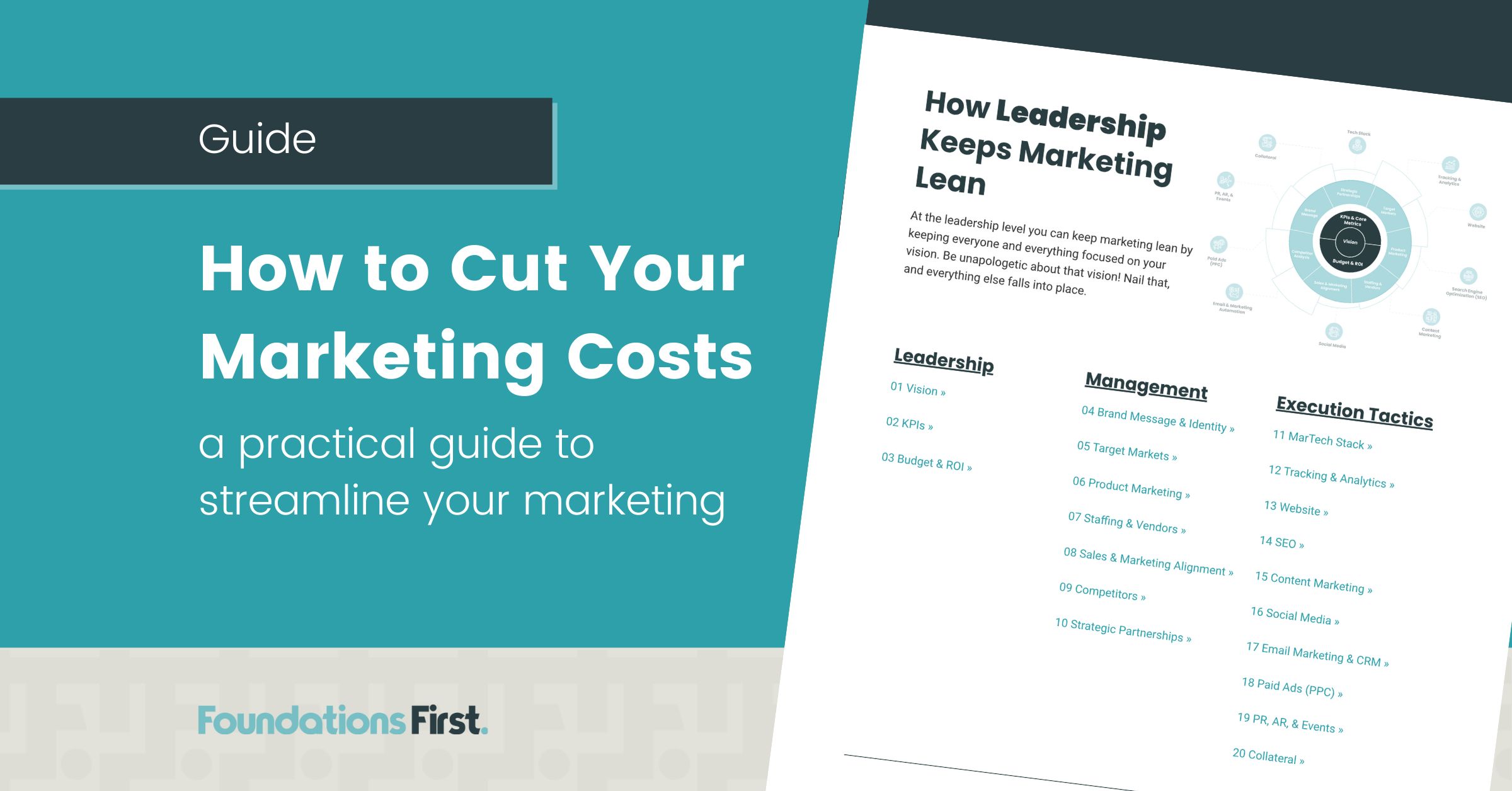With or without a recession, we believe in streamlined marketing operations
When the COVID-19 pandemic hit in 2020, the world changed. From how we communicated to how we shopped for groceries–it all looked different. Businesses suddenly faced unusual new challenges which, for many, would determine their future. The businesses that did well and survived the test had previously streamlined marketing departments with limited spend. These successful businesses were very strategic about what tactics they used. On the other hand, the businesses that struggled through the pandemic frantically tried to cut marketing budget, but they didn’t know where to start. Should they stop social media? Maybe decrease their ad spend? They had no plans or tactics in place to determine what to cut. Without knowing what to cut, businesses played Russian roulette with their budgets. It was a game many of them lost.
If the COVID-19 pandemic taught businesses anything, it’s that they must have a plan. Fast forward nearly three years later and a new crisis looms. Anyone who reads or watches the news knows that there is talk of the big R word–recession. Now is a great time to review your marketing operations.
Before you panic and start having toilet paper shortage flashbacks, remember you don’t need to overhaul your entire marketing budget. You simply make little adjustments that make a big difference. Consider the Pareto Principle, aka the 80/20 rule. The Pareto Principle is the idea that 20% of the effort or input leads to 80% of the results or output. In other words, if we focus a little of our efforts on what is most important, we will yield greater results than focusing on as many things as possible.
As you start looking at your marketing budget for next year, determine where you can afford to cut marketing spend and where you might want to reinvest that budget. We’ve listed out essential questions for each aspect of marketing to help you develop a plan and streamline your marketing operations.
This approach ensures you’re doing the right things, not just more things.
Jump to a section:
How Leadership Keeps Marketing Lean
At the leadership level you can keep marketing lean by keeping everyone and everything focused on your vision. Be unapologetic about that vision! Nail that, and everything else falls into place and makes cutting your marketing budget much easier.
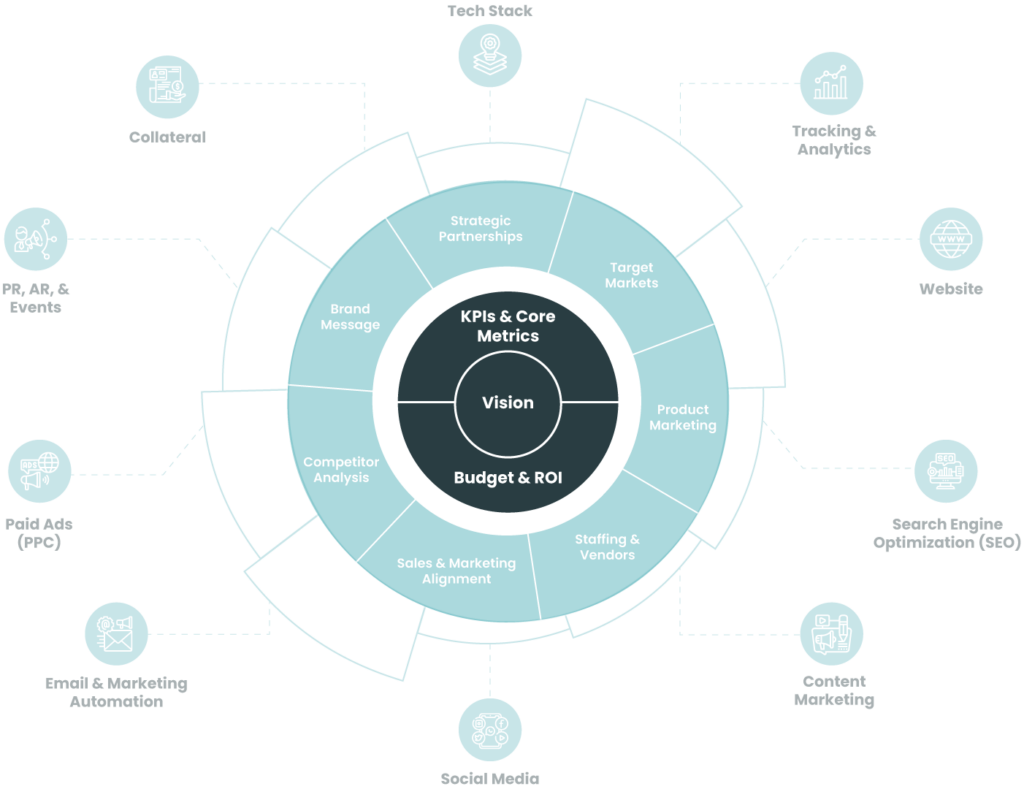
01 Vision
A vision recognizes where the company is going.
Vision is the most important aspect of your brand and business. It guides your choices and ensures your goals are aligned with the end result. Every aspect of your business should revolve around your goal. If it doesn’t, that’s a big problem. Your marketing department must have the vision wrapped around everything it does.
Why a clear vision helps you strategically guide marketing and cut marketing costs when needed:
Streamline your marketing spend by ensuring the marketing department is on point with your vision. Anything not aligned with your vision can get cut immediately. And I mean immediately.
If you don’t have a vision (not a mission statement) of where the company is going that is measurable and clear then we should talk. Having your vision well documented and communicated will save you more than any other section below. If you don’t have one, stop reading and start figuring out what you want for your business.
Ask yourself:
- Big picture, how is marketing overall supporting our vision?
- How is it getting us closer to our vision?
- Is it a mess and needs to be completely revamped, or is it solid?
- Does our marketing team understand that vision?
Examples:
- Our vision is to work with 20% of Fortune 500 companies. Marketing efforts are 100% focused on that goal. Each marketing team member knows this goal.
- Our vision is to work with 20% of Fortune 500 companies. Marketing efforts are not completely focused on that goal. Marketing is unclear on the company vision.
Need to define your vision? Download our Vision worksheet to get you started.
Download Vision Worksheet (docx)02 KPIs (Key Performance Indicators)
KPIs are how you measure progress to your vision.
KPIs determine success, but first you have to know how to use them. When it comes to KPIs, you’ve got to be particular. Don’t set more than you absolutely need. It might be tempting to track all the fun metrics, but only focus on the important ones. If you can’t hire or fire someone based on the KPI, it’s not worth tracking.
Why marketing KPIs save you money:
Your KPIs should ladder up to your vision – your goal – your “one thing” you’re trying to accomplish. If your KPI data doesn’t then it might just be noise. Don’t waste your time reporting data unless it’s actionable.
Most importantly, everything you do should ladder up to your KPIs. If you don’t have these documented and your team isn’t clear on the goal then your marketing will get scattered. Keep in mind it’s never black and white when it comes to marketing attribution, but conceptually all efforts should be focused on your KPIs.
Ask yourself:
- Is marketing able to show measurable impact on progress to our vision?
Examples:
- Marketing has clear KPIs and reports on them regularly to show contribution towards the KPIs and vision.
- Marketing has documented way too many “KPIs” that are confusing or irrelevant. They need to choose KPIs that show direct measurement towards the vision.
Need help with KPIs? Download our KPI worksheet to get you started.
Download KPI Worksheet (xlsx)03 Marketing Budget & ROI
Ensure your marketing leadership is a good steward of the marketing budget so you know what isn’t working that you can cut.
Do you know how much money you need to spend on marketing software subscriptions or when your big renewal expenses are going to hit?
Does leadership have to approve every credit card purchase, holding up productivity?
Can you calculate your total ROI from marketing efforts?
We see a lot of money wasted on unnecessary subscriptions and time wasted on staff waiting for multiple approvals for a $20 credit card purchase.
A budget cuts marketing costs, keeps marketing efforts transparent, and keeps the team accountable and empowered to make quick decisions.
Why a clear budget keeps you thinking creatively and lean:
Gartner states that 26.2% of marketing budgets are for tech. Being a good steward of a marketing budget means continually making sure you’re only spending money on tech you need and on projects that are aligned with your KPIs and vision. The budget is a critical accountability piece. It forces the marketing team to ask if the initiative is absolutely necessary and if there is somewhere else they should invest first.
To be clear: your budget is the guardrail for all of your efforts. It keeps everyone focused and lean.
Ask yourself:
- Is marketing clear on its budget?
- Has it been documented?
- Do we know what we’re getting for that budget?
Examples:
- Marketing doesn’t have a well-documented budget, so we don’t really know what it’s costing to run that department.
- Marketing reviews their budget quarterly and is a good steward of the spend to make sure they are spending it on projects most likely to move the needle towards our vision.
How Management Streamlines Marketing
At the management level it’s all about making sure the team is focused on the right products, the right target markets, and is running as efficiently as possible and keeping it that way. It’s also management’s job to push back and remind leadership of the stated vision and goals and how all of the efforts ladder up to the KPIs set by leadership.
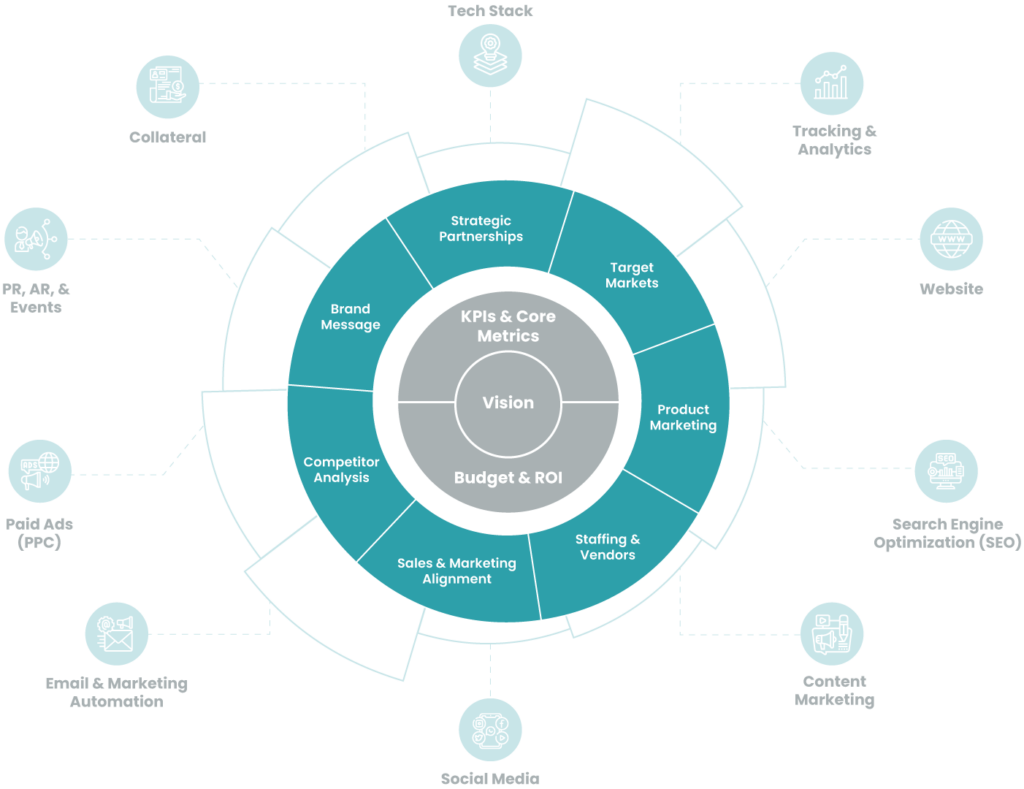
04 Brand Message & Identity
Be clear and consistent in how you look and sound.
Brand messaging is your voice. It’s the way the world sees you. It sets your company apart from the competition, tells your story, attracts customers, and shows your audience that they can trust you. When you’re not clear and consistent in how you look and sound, that trust can easily dissolve. It’s a waste of time and money—not to mention confusing to your audience—when marketing constantly reinvents the wheel.
Why a clear brand message & identity saves you precious marketing time and money:
If you’re looking to streamline your marketing, make sure your messaging is clear. Your brand messaging, tone, values, colors, log usage, fonts, ect. are not helpful if they only exist on a remote hard drive that no one has access to.
Marketing must have an easily accessible go-to brand guide that gives everyone the basics to keep all assets on message and looking consistent. This will save a ton of time in multiple revisions of content, and designs will be templatized to cut down on production time.
You can easily cut the workload in half and cut marketing costs just by getting your brand message and identity shored up.
Ask yourself:
- Does everyone use our brand message and identity well, or are they trying to develop new “creative” assets?
- Does it seem like there are always a million revisions to anything created?
Example:
- Marketing doesn’t have a well-documented brand message and identity guide. We’re spending a lot of extra time creating content than we need to because of extra rounds of revisions.
05 Target Markets
It’s about who you serve.
Target markets work best if they are clear and prioritized. During the day-to-day grind of marketing operations, it’s often difficult to prioritize efforts. If there is a clear target market hierarchy, content, events, and ads for the primary target market will take priority.
Why focusing on 1 or 2 target markets is the road to efficient marketing:
Again, consider the Pareto Principle. You’re likely getting 80% of your revenue from 20% of your customers. With that said, you should always spend most of your time nurturing that 20% target market—and not just during a recession. Put your focus and attention on the target markets that are going to get you to your vision most efficiently. Period.
Resist the urge to serve too many markets and water down your message!
Ask yourself:
- Who are our target markets, and which one is getting us closer to our vision the best?
Example:
- We have 5 primary target markets, but the top 2 account for 80% of our revenue. We’re spending 75% of our marketing efforts on the other markets. We need to shift that to focus on the top target markets.
06 Product Marketing
What you’re selling matters, a lot.
Every product you offer is important, but let’s be honest for a minute. Some are more important than others. Just like Syndrome said in The Incredibles, “When everyone’s super, no one will be.” You cannot promote every product the exact same way and expect the same result. If you are, you’re throwing a ton of money down the drain.
Think about it. You don’t cater to your target markets the same way. You shouldn’t cater to your products the same way either.
Why focusing on your core product lines is a winning strategy for cutting your marketing budget:
Just as with target markets, the same concept goes for your product lineup. More than likely, 20% of your product offers generate 80% of revenue. Focus on those product lines and optimize them. Look at ways to upsell or cross sell within those core products.
Ask yourself:
- Which product lines are generating the bulk of our business?
- How can we leverage those more fully?
- Are there any product lines that are at their end-of-life and need to be sunset?
- Are there any pet projects that aren’t aligned with the vision taking up resources?
Example:
- Our top product accounts for 75% of our revenue but we haven’t given it much attention in the past. There is opportunity to increase our rates and make the product even better. Doing this is a better investment of our time right now than creating a brand new product.
07 Staffing & Vendors
Determine who is doing your marketing to cut costs, fast.
Knowing your team is important. Trusting your team is critical. Unfortunately, the trust you have for your marketing team can get cloudy as teams change. Marketing teams get bloated with vendor contracts. Staff may not be necessary at the levels they once were. The team that got you here is likely not the same team that will get you to the next iteration of your business. Know who is in the ring with you now and change it if you need to.
Why a small team of A-players beats a big team of B players every damn time:
You probably instinctively know who your 20% A-players are that are generating 80% of the productivity. Make sure you keep them. Don’t assume they will stay during a recession. To improve your team, let your B and C players go or replace them with A-player part-time contractors. Remember the old adage that one rotten apple can spoil the barrel? Having B and C players on your team can push out your A-players very quickly.
You know why A-players are usually A-players? They often appreciate training. Consider moving some of the outsourced tasks like SEO and webmaster to an in-house person and provide training and a bump in pay. This move keeps your A-players excited about their job and you save on a spendy vendor contract you no longer need to renew. Cut costs and save your outsourced tasks for really advanced techniques and train your in-house staff on everything else.
Ask yourself:
- Who are my A-Players? What do they need to stay?
- Who are my B and C players? What value are they providing and is it the best way to move towards our vision?
- Is there a better mix of skill sets needed?
Example:
- It’s time to renew our SEO agency contract but they mostly handle onsite SEO maintenance. Instead of paying them $20k for another year, we’ll invest $5k into staff training and give a $5k pay bump to whomever takes that on. That leaves us with some extra budget in case we need an SEO contractor for anything advanced.
08 Sales & Marketing Alignment
Marketing and sales must support one another.
Marketing should support sales and sales should support marketing. But this accord can only happen if there are clear communication expectations between the two department leaders.
Is the sales team getting junk leads and not telling marketing? Guess what? They are going to continue to get junk leads. If sales want better leads, then marketing needs to know what a better lead looks like.
For true alignment to happen, both departments must be on board, have open communication, and be specific in what each need from the other.
Why sales & marketing communication is critical to keeping marketing focused and within budget:
Sales can provide near real-time insights on customers and prospects. If that info is shared with marketing regularly, then you have built-in customer research which makes all marketing 10x more effective.
That communication relationship is critical. If your sales and marketing teams are at odds and having weekly blame-storming sessions, you’re leaking time and money. If you want to cut back on spending and be more efficient, fix this ASAP.
Ask yourself:
- Are sales and marketing supporting each other as well as they can?
- Is marketing working off assumptions rather than taking to sales to confirm?
Example:
- Instead of collaborating, my teams argue about who is to blame for less leads this quarter. To streamline, we’ll create a system for a collaborative relationship to focus on the right KPIs and make sure no one’s job is on the line so long as everyone is working toward the common goal.
09 Competitors
Find out what your competitors are up to.
Evaluating your competitors’ successes can be helpful, as long as you keep your vision in mind. Remember when your mom asked you, “If all your friends jumped off a bridge, would you, too?” Same idea. Just because your largest competitors are dumping money into a platform or program, that doesn’t mean you should as well. If your competitors are advertising on Facebook, it may seem logical that you do. Following in your competitor’s footsteps can be helpful, but it can also be a waste of money.
Why wearing blinders can be a good thing to keep your marketing costs down:
Competitors change. They launch new messaging, adjust their ad strategy, and build new products. It can be tempting to keep up with the Jones’, but you have to remember your vision.
It’s not necessary to keep track of everything your competitors are doing, but your team should focus on the important data. Decide what to look for and how often to review it. Keep your comparisons realistic and your vision front and center.
Ask yourself:
- What do our competitors offer and how is it different from what we offer?
- Are we doing things just because our competitors are?
- Do these choices align with our vision?
Example:
- Our largest competitor advertises on Facebook and posts videos on TikTok; we followed suit. When we evaluated our ROI, we realized these things weren’t bringing us closer to our vision. We will continue monitoring our competitor for strategies that will take us toward our goal.
10 Strategic Partnerships
What people say about you is important.
The relationships you make with other companies can be invaluable. Strategic partnerships are mutually beneficial and allow your business to grow while expanding your customer base, brand awareness, and overall reach.
With all the benefits that come from strategic partnerships, it can be tempting to hold on to each one you have. However, you need to consider which business relationship is most beneficial to your company. Decide which ones align with your vision and which ones aren’t quite a fit anymore. Once again, here’s where the Pareto Principle comes into play.
Why it’s okay to ease up on some partnerships and good to double down on others to make sure you’re using your marketing budget and resources effectively:
Relationships are meant to go both ways. If a strategic partnership isn’t doing much for you, trim down what you’re giving to them. Cut back on your nurturing of the 80% of your strategic partners that aren’t bringing in any leads. Focus on the 20% of your strategic partners that are getting you closer to your vision. Put even more energy into that 20%.
Revisit your strategic partnership processes and see where you can add something special. Or see where you can automate without it feeling like an automation. You don’t need to make major changes. It could be as simple as the top 20% of your partners get a better holiday gift than the other 80%. Do you see how we’re able to economize while focusing on the big producers?
Ask yourself:
- Am I nurturing our top 20% of strategic partners enough?
- Am I spending too much time on partners that are unlikely to result in any benefit?
Example:
- Our CEO likes to sign every single holiday card personally. This year they will only sign 20% and spend the extra time personally calling the top partners.
How Execution Tactics Streamline Marketing
At the tactical level, it’s all about leveraging each tool as much as possible. A little training can go a long way to being more effective in every single thing you do.
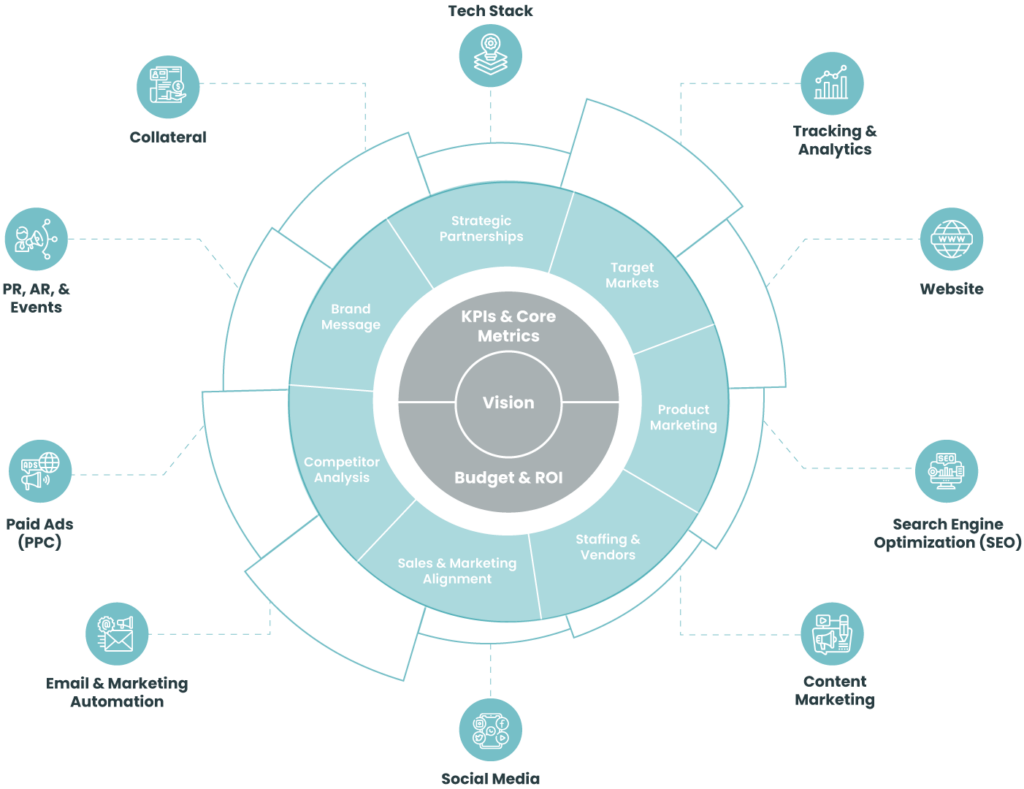
11 MarTech Stack
Use the right tools for the job.
Let’s face it. None of our businesses would be where they are without the technologies we use to get us there. All of those tools, platforms, apps, and software help us achieve our goals. It’s easy to want to use all the fancy new tools out there while also holding on to the old—and likely outdated—tools you used and loved in the past. But it’s also easy to waste money unnecessarily on your tech, too.
Why it might be time to let go or consolidate your marketing tech stack to cut your marketing budget:
A couple monthly subscriptions here and there may not seem like a big deal, but those $25-a-month subscriptions add up to big savings when you go through and shut them off. Tech constantly changes. What you needed 3 tools for a year ago might be consolidated into 1.
The key is to take some time to document your tech stack and make sure each and every item is helping you get closer to your vision. Determine what is a “nice to have” vs. “have to have.” Be brutal when you go through your stack.
Think about all that wasted time and money on subscription renewals. It adds up quickly, doesn’t it? Streamline this process by scheduling a day to agree on subscriptions once a year. Beyond that allotted time, leadership should never be bothered with renewal questions. And please make sure the person owning the tech stack has a corporate credit card. The social media manager should never have to bother the VP of marketing for the credit card for a $25/month subscription. What. A. Waste.
Ask yourself:
- What tools are we using?
- What can we consolidate?
- What can we turn off until we need it again?
- Is there a more cost effective alternative now on the market?
Example:
- It turns out we could consolidate our subscription for Adobe Creative Suite saving $250 a month. That’s a $3k savings for about 15 minutes of work. We can do the same with other tools.
Want some help? Download our Tech Stack worksheet to get you started.
Download Tech Stack Worksheet (xlsx)12 Tracking & Analytics
Track everything to make sure you’re doing the right things.
I am convinced that most dashboards only exist to look pretty, and no one actually uses them. I’ve also seen multi-tab spreadsheets of useless data that exist only to prove someone is doing something from 9-5pm.
Knock it off. You’re wasting valuable time and money.
Get your tracking as accurate as you can for only the metrics that matter and ladder up to your KPIs.
Why your reports can go straight in the trash and you should learn to trust your team – which keeps your marketing costs down while your team focuses on more important revenue generators:
When it comes to KPIs, you’ve got to be particular. Don’t set more than you absolutely need. It’s tempting to track as many KPIs as you can, but focus only on the non-bs ones instead.
While you’re at it, rethink reporting on organic search traffic as well. Sure, you can look at that data, but don’t take the extra time to report on it unless it’s really going to ladder up to your big KPIs.
And yes, this takes more trust. But remember, at this point you only have A-players on your team. You should trust them to do their jobs well without creating a million dashboards and spreadsheets to prove they are doing something. Let them spend them time on DOING not REPORTING on the doing.
This shift alone will cut marketing costs and save you precious time so you can be much more productive.
Ask yourself:
- What reports are we creating?
- Are they useful or pretty much useless?
Example:
- The social media manager spends 2 hours a week preparing social media reports. We are going to stop that immediately and only report on sales qualified leads coming from social.
13 Website
Check the health of your digital storefront.
It’s time to review your hosting options. Do you really need to pay extra for redundant servers? Has your hosting provider added new security measures that you no longer need to provide separately?
Seriously, this happens all the time.
Why paying attention to your website infrastructure can save you marketing money and headaches:
Take the time to look at your website infrastructure—from hosting to the plugins and add-ons you’re paying for. Web tech changes so quickly you can likely consolidate a lot of the tools which saves both time and money for a 30-min review.
Don’t forget to look at what your website connects with. Are you using Zapier to connect forms to your CRM? See if there’s a native integration so you can shut off that paid Zapier account. Or maybe you can now connect your site to your CRM more efficiently and cut out some admin time dealing with web forms.
I see a lot of wasted time in dealing with spam form submissions. Yeah, I know, it’s only a couple minutes a day, but it’s annoying, distracting, and that time adds up. Take 15 minutes and make sure you’re using the latest reCAPTCHA on your forms.
Ask yourself:
- Where are we spending time and money on the website that is annoying?
- How can we cut back and simplify?
Example:
- By swapping out the forms on our website, we were able to capture information directly into our CRM which cut our manual review workload in half.
14 Search Engine Optimization (SEO)
Consider how you look to Google.
Search engine optimization (SEO) is intimidating. You may think it’s in your best interest just to let someone else deal with it so you know it’s being done right. Besides, SEO isn’t something you can cut back on…right?
You’d be surprised.
Bringing SEO in-house allows you to leverage SEO in everything you do making it much more effective as a marketing tool for half the cost:
A lot of SEO requires one-time setup and some maintenance. Focusing on SEO that you can control is a huge benefit. Remember the training that you were going to offer to those A-players? Time to train your in-house staff on SEO basics rather than outsourcing! SEO touches a lot of different areas, so having someone trained up just a little bit will pay big dividends.
You might still need an expert to give you a list of stuff to fix every few months, but it won’t be anything your in-house staff can’t handle. This will keep your SEO improving without a big monthly fee.
Another tip: move to quarterly SEO assessments rather than a monthly contract.
In short, be realistic about how you’re using SEO to get closer to your vision. Handling the basics in-house might be plenty. Reserve the really advanced strategies for SEO specialists and get everything else back in-house.
Ask yourself:
- How are we using SEO to get closer to our vision?
- Can we move SEO maintenance tasks in-house and cut back on external vendors?
Examples:
- We were able to discontinue with an SEO agency and instead got training for in-house staff and a subscription to SEMrush. We saved $15k from that one decision.
- We were able to consolidate vendors for a better package price. Our content marketing firm added SEO as a service for half the price and same deliverables as our stand-alone SEO vendor. This cut down on content time since SEO was included and saved us money.
15 Content Marketing
The what and why of the content you create.
Too much of anything isn’t good for anyone. Churning out new content for the sake of new content isn’t going to help you reach your vision. Besides, I can guarantee your audience isn’t watching to see if you publish a new blog post every single week.
It’s okay to cut back. In fact, I recommend it! Instead of publishing 4 posts a month, publish 2. Watch your KPIs and see if anything changes.
Why creating less content could be a winning and cost-effective strategy for your marketing plan:
It’s worth stepping back and looking at your content production. You don’t want to spend your valuable time spitting out content if it’s not beneficial. As you probably guessed, the Pareto Principle works here, too.
Here’s how you get more with less: Spend 20% of your time creating content. Spend the remaining 80% of your effort distributing that content to all the channels where you can reach your ideal customer. Be strict about this. Do not create anything new until you’ve maxed out what you can do with previous pieces. Repurposing is how you multiply the impact of your content by 10 or 20 times while saving bunch of time and money.
In my interview with Tiny Marketing, I reiterate how producing less content isn’t the same as producing no content. The biggest waste is in creating new content when old content could be much more powerful. Here’s how that might look:
Go back and evaluate your top 20% of content. Can you repurpose it to give it fresh life? Can you repurpose it into a different medium – as in, can you turn a video into an e-book? Can you redistribute it again with a fresh look? If you have 5 hours, don’t write a new post. Optimize an old piece of content that was performing really well. Consider a cross link to new content now. The opportunities are endless.
Ask yourself:
- Can we do a better job of repurposing our new content?
- Can we leverage old, high-quality content and make it new again for half the effort of creating something new?
Example:
- We had 5 blog posts that were driving 80% of our website traffic and it was high quality traffic. Instead of writing new content, we repurposed those pieces into 120 posts, video clips, etc. for way less time than creating new assets. Our prospects love it because it’s already a topic they are interested in.
16 Social Media
Focus on being social and actually engaging, or consider letting it go.
Are you using social media just to use it? Is it truly beneficial to your business?
Having a presence on social media isn’t for every company. It’s not necessary to be on every platform if that’s not where your target audience is. A successful social media presence is one where you choose your platforms wisely and use them effectively.
Why it’s okay to not spend time and money on social media – yes, I said it…stop spending so much time and money on social media:
If you don’t have the time and money to strategically use social media…get off the platforms.
Okay, not really.
But cut back your effort by 80%. If you don’t have the time to be strategic about how you’re using social media, then you can just stop using it. You’ll never build your audience’s trust with outdated or incorrect social media content.
When you do use social media, make sure your profiles are accurate, on brand, on message, and represent you well. Remember, you don’t need to post often, if at all. Maybe do a post a quarter just to have something timely on your feed, but that’s about it.
Until you’re really ready, I’m giving you permission to cut your social media.
If you’re simply not sure what “doing” social media really means and are considering outsourcing, I can help you navigate those waters. Check your outsourcing readiness with my guide to outsourcing your social media and start taking the next step! Hint: you might not need to be doing social at all – the guide will help you decide if it’s right for you.
Ask yourself:
- Are we really getting anything from social media?
- Is it helping us get closer to our vision? If so, how? Is that the best use of our time and money?
- Do we have the time and money to invest in social knowing the return could be far in the future?
Example:
- We were paying a social media manager $4,500 a month to post on 3 platforms 5 days a week. We had next to no engagement except from staff. We provided basic training to an in-house staffer just to watch and maintain the accounts and post every once in a while. We have seen no negative results from the move. We were throwing away money before.
Need a social media strategy? Download our guide to outsourcing social media to make sure you're ready to fully leverage it.
Download Social Media eBook (pdf)17 Email, CRM, & Automation
Be a good emailer. Don’t be a spammer even if it’s legal.
CRM (Customer Relationship Management) software is a system for managing your relationships with customers. But did you ever stop to think about what that means? Customer relationships are really the basis of how you should think about interacting with your existing and prospective customers. The key word here is “relationship.” You could easily blow that relationship by sending too many emails or sending emails that your customer or prospect doesn’t find valuable.
It’s time to rethink how you’re using email.
If you’re sending out a monthly company newsletter that’s all about you, stop. At least move to a quarterly newsletter. More than likely, your audience isn’t that interested. Ask yourself if your email list truly wants to get the email. How is it relevant and beneficial to them?
Simplify and cut back your email marketing quantity for higher-value campaigns:
Email might seem cost effective, but it’s a lot of work to code, test, and send those emails. A lot of work = a lot of time and money. Then, of course, you have to deal with the fear of getting blacklisted if one too many people flag it as spam just because they were having a bad day.
Aside from that, laws are changing all the time and it’s getting harder to get people to double opt-in.
Cut your marketing expenses by being strategic in how you’re emailing. Consider only sending 20% of the emails that you normally would and make them really good and valuable.
Ask yourself:
- Do the people on our list really need or want what we’re sending out?
- How can we use email more effectively?
- Are we just sending emails to stay “top of mind” and not providing real value?
Example:
- We spent 20 hours a month creating the company newsletter including the CEO, managers, writer, and email manager. When we moved to a quarterly newsletter, our recipients engaged more and we saved 40 hours a quarter of work. Our newsletter is even better because we only include content that’s valuable to the recipient.
Review this exercise before you send your next email campaign. Download our email strategy worksheet before you send any other emails.
Download Email Worksheet (docx)18 Paid Ads (PPC)
Figure out where you’re spending your ad money.
Paid advertising is a great way to quickly increase traffic and conversions. But it is also an easy place to overspend. If you’re honest with yourself, you’ll find that you probably don’t need to advertise in all the places you are. Perhaps some of your favorite ads just aren’t producing leads like you’d hoped.
There are near endless ways to streamline your paid ads, but the big takeaway here is to take a close look at the quality of leads coming in through your ads.
Trim out bloated marketing ads for a lean, high-performing ad program:
If your ads are top of the funnel and going to take a long time to nurture, consider adjusting your targeting to middle or bottom funnel prospects.
For paid efforts, it’s really about moving money and resources to the campaigns bringing in the most value. Cut back your experimentation a little bit and get brutal with your ad spend.
As an exercise, I like to ask clients how they would adjust their ad spend if I took away half of their budget. Turns out that after doing the math, they would net about the same results because their best campaigns were doing the bulk of the work. And yes, the Pareto Principle comes into play with ads too. 20% of the ads bring in 80% of results.
Same result. Half the cost. Talk about economizing!
Ask yourself:
- Are we being brutally honest about what ads are bringing in the most return?
- Are we advertising in places just because a competitor is there? Does it bruise our egos to not show up?
Example:
- We shut off 80% of our ads and focused on the 20% that were performing the best. The additional attention to the 20% made them even more effective. We no longer had endless meetings about new ad copy and what to try next. We were much more focused in our ad copy and optimized the entire experience through the landing page and beyond. We didn’t have time for that before because we were trying to optimize so many ads.
19 PR, AR, & Events
Up your event game.
Hosting a conference, webinar, or event is a lot of work. However, I often see marketing teams making it even more work for themselves by making unnecessary or redundant preparations. You don’t need to start from zero every time you host.
Time to get your processes lined up!
Why an event planning process keeps you organized, clear, and focused on the marketing tactics most likely to generate leads and revenue:
Get your process down and get it into your project management system like ClickUp or Asana. These systems make it fast to get everyone on the same page with the upcoming event. This will cut down on the useless meetings and millions of follow up emails just to coordinate it.
Truly, process and project management are a huge saver for events. Same for press releases and analyst relations.
Ask yourself:
- Do we need to host all of these events?
- Which events accounted for the most return on investment?
- Will these events get us closer to our vision and is it aligned with our target market?
Example:
- Instead of going to all of the conferences, we doubled down on the most fruitful one and had a much smaller presence at the others and even didn’t participate in a few. This kept us really focused on the big event and we leveraged the hell out of it making it the most successful tradeshow in 5 years.
20 Collateral
Stop reinventing the wheel every time you need an asset.
Templates exist for a reason. Beyond saving SMBs a boat load of time and money, templates are easy to use and can also benefit companies by:
- increasing flexibility
- providing consistency across projects
- easing the workload
- offering structure
Why marketing collateral templates save time, money and frustration:
Templates are a dream, but very few SMBs have them created well enough to actually save time. It also takes a team of people that understand how to stick to a template to see the real benefits. If you don’t have templates for the majority of your assets, it’s time to build those.
Part of this process is thinking about sales and how sales needs to access the most recent case studies, the latest pitch decks, how they are customizing their pitch decks, etc. Talk to sales and get a system in place that works the way they need it to work. For some teams Dropbox is enough. Others need a sales tool portal that is more robust.
Having this system in place is a game changer. Trust me. Your team will take it for granted within a few months and it will be magical.
Ask yourself:
- Can we make a template for assets we regularly create?
- Where can we store the final asset so internal staff has quick and easy access?
- How can we tell everyone when a new asset is available?
Examples:
- We used to start from scratch for every social media post we created. Now we pick from 5 different designs and it takes us half the time it used to. The best part is it’s sized perfectly and on-brand.
- Sales reps were customizing their sales decks so much that they hardly looked like our brand and it was taking them hours to prep the deck for each presentation. After just one meeting with the sales reps we were able to rebuild the template in a way that gave sales the flexibility they needed so they could customize the deck in 1/4 of the time.
Don’t wait for the next crisis to make your marketing operations more efficient. Whether it be a pandemic or a recession, cutting marketing spend in the right places will help you streamline your business.
The tiny adjustments that you make now will add up to a huge change in the way your company operates and saves money. When you focus on the top 20% of what’s working the best—from ad spend to your staffing—you’ll be amazed to see the other 80% fall into place.

